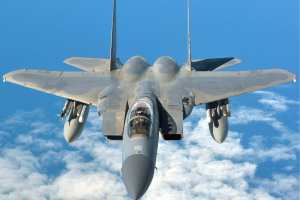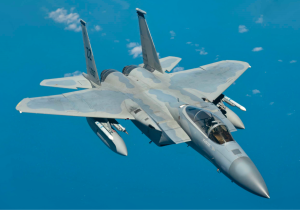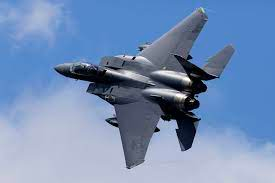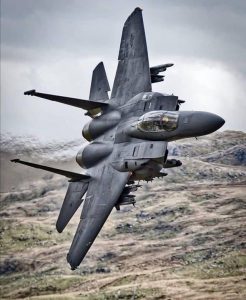The F-15E Strike Eagle, a formidable symbol of American air power, stands as a testament to the United States’ commitment to aerial dominance. Renowned for its versatility, speed, and lethality, the F-15E has earned its place as one of the most revered fighter jets in the world.

Design and Development: Developed by McDonnell Douglas (now part of Boeing), the F-15E Strike Eagle is a dual-role fighter designed for both air-to-air and air-to-ground missions. It is an enhanced variant of the F-15 Eagle, incorporating upgraded avionics, sensors, and weapon systems tailored for multi-role operations.
The F-15E features a twin-engine design, powered by Pratt & Whitney F100 turbofan engines, providing exceptional speed and maneuverability. Its sleek aerodynamic profile, coupled with advanced fly-by-wire technology, enables the aircraft to perform high-speed maneuvers with precision and agility.

Combat Capabilities: Equipped with a formidable array of weaponry, the F-15E Strike Eagle is capable of engaging both aerial and ground targets with devastating effect. Its primary air-to-air armament includes AIM-120 AMRAAM and AIM-9 Sidewinder missiles, while its air-to-ground arsenal comprises precision-guided munitions such as JDAMs, AGM-65 Maverick missiles, and laser-guided bombs.
The F-15E’s sophisticated radar and targeting systems, including the APG-70 radar and LANTIRN targeting pod, provide unmatched situational awareness and precision strike capabilities. This allows the aircraft to operate effectively in all weather conditions and engage targets with pinpoint accuracy.

Operational History: Since its introduction into service in the late 1980s, the F-15E Strike Eagle has played a pivotal role in numerous military operations, including Desert Storm, Operation Enduring Freedom, and Operation Iraqi Freedom. Its ability to conduct deep-strike missions, close air support, and air interdiction has made it a versatile asset in conflicts around the world.
The F-15E’s combat record is a testament to its effectiveness in both conventional and asymmetric warfare scenarios. Its speed, range, and payload capacity make it a formidable force multiplier, capable of dominating the aerial battlefield and striking deep into enemy territory with precision and lethality.
Future Upgrades: As the F-15E continues to serve as a cornerstone of the United States Air Force’s fighter fleet, efforts are underway to ensure its continued relevance and effectiveness in the modern battlefield. Upgrades such as the Eagle Passive/Active Warning and Survivability System (EPAWSS) and the Advanced Display Core Processor (ADCP) are enhancing the aircraft’s survivability, situational awareness, and combat capabilities.

Conclusion: The F-15E Strike Eagle remains a cornerstone of American air power, embodying the principles of versatility, lethality, and technological superiority. As it continues to evolve and adapt to meet the challenges of the 21st century battlefield, the F-15E stands ready to uphold its legacy as a symbol of air superiority and a guardian of freedom and security.





